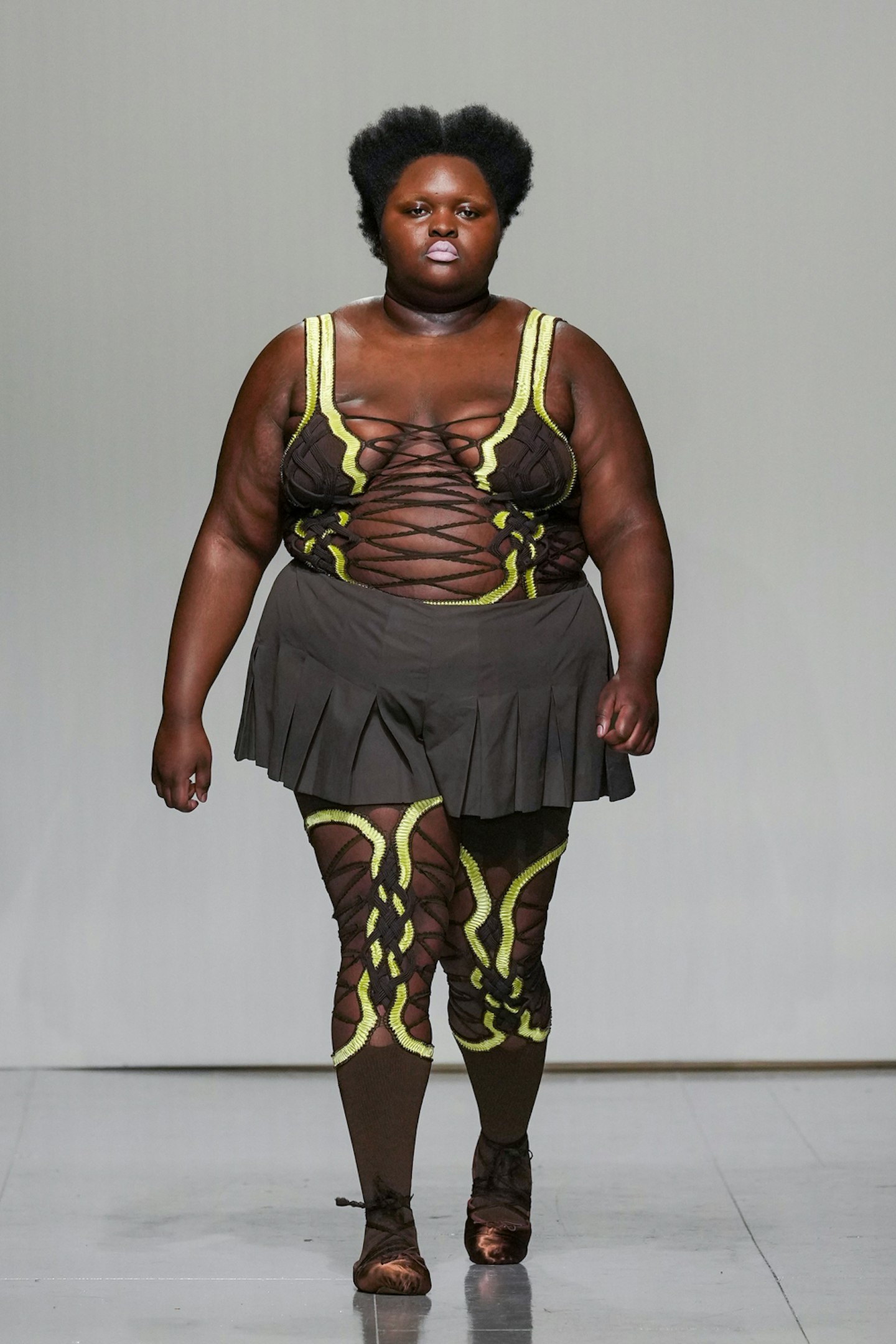There were some seriously great clothes at Milan Fashion Week. Elongated pencil skirts with low-slung waistbands. Sheer cowl-neck dresses. Sharp three-piece suits. Full skirts that flared. Velvet ballgowns. But what all of these outfits had in common - and which chimed with the prevailing mood on the catwalks in the fashion capital of Italy - was that they were all worn by models with almost exactly the same body type.
According to fashion search engine Tagwalk, in a stat that has been widely shared since it was posted two days ago, Milan had 77% fewer curvy models on its runways compared to London. The comments underneath said it all. 'Do better,' said one user. 'Is Milan taking Ozempic?' said another, referring to the injectable diabetes medication that is now widely taken as a weight-loss drug. In this week's issue of New York Magazine, which depicts a fork piercing a plastic syringe, the cover reads, 'So many people (and half of Hollywood) are suddenly thinner, having swapped their old diets for a dose of the diabetes drug Ozempic.' Hitting newsstands on 27 February, coincidentally the day after the last show of MFW, the conversation seems to have come full circle. We still live in an age where being a certain, very specific, size appears to be the ultimate achievement. To put it crudely, the fetishisation of thin is still in. As one user called it on Instagram: 'One step forward, two steps back.'
It was a slightly different story in London, a city that anecdotally (and now statistically) has been better at showing a wider range of bodies. At Karoline Vitto's show at London Fashion Week, the smallest model on the catwalk was a UK 10. 'In London there is an expressive group of inclusive emerging designers, and we have been slowly carving out a space for ourselves over the last 3-4 years,' she tells Grazia. The Brazilian designer, who shows as part of the famous talent incubator Fashion East, wanted the casting for her most recent show to reflect her real customer base, hence why the sizes ranged to a UK 20. 'Having a standard casting, comprised solely of UK 6/8 models, has never been an option for me,' says Karoline. 'I don’t sample on those sizes. My sampling size is, normally, a UK 16. From that point, I grade up or down. But I never start from a small size, so it would be counterintuitive to have a standard casting, and we wanted to be truthful to my creative process,' she explains.
At her show on 17 February, Karoline meditated on the structured silhouettes that dominated the 1980s, with form-fitting skirt suits that were laced together with spiralling metal inserts, celebrating curves and accentuating folds. A flame red two-piece was worn by Monët-Lauren Gordon, model and a muse of Karoline's, who was cast in three shows as part of London Fashion Week. 'If 10 year-old, fashion-obsessed me could see me walking a show like Karoline’s, my jaw would be on the floor,' says Monët-Lauren, who describes the atmosphere backstage as incredibly supportive. 'We all share common stories and feelings of gratitude that we are blessed enough to represent women like us. We all looked phenomenal and felt it too,' she says.
In terms of whether the fashion industry is moving forwards or backwards in terms of showing more size inclusivity, Monët-Lauren says that, season to season, it feels like a guessing game. 'Gratitude and excitement are partnered with a niche anxiety as a curve model; you never know whether your body is ‘in’ or not,' she says. 'In a historical context, there’s no denying that it’s moved forward from the traditional norm. There are still boundaries, there’s a standard for ‘acceptable’ plus-size girls etc. I understand that some representation is better than none, but we still have a lot of work to do.'
The evidence, plain for all to see, is that she's right. In London, some designers are steadfast in their commitment to being size-inclusive, not because it's fashionable but because it's part of their brand's DNA. (Sinead O'Dwyer is one of them. For her latest show, she worked with casting director Emma Matell, together building a language that 'represents the people we want to design for and dress,' she says, adding, 'We are offering styles in sizes that have not been offered before within the luxury sector, aside from custom/made to measure.') Others include a nod to inclusivity with a smattering of what is known as 'mid-size', as well as curve, models among a largely homogenous line-up. Others, meanwhile, make no attempt at size diversity whatsoever - even in collections featuring almost 50 looks.

Back to the statistic from Tagwalk, Monët-Lauren says that it surprises her. 'I don’t understand how they don’t see how much they’re missing out,' she says of the brands who show in Milan. 'London was so fun and exciting this season. From Di Petsa to Karoline Vitto - these designers, and the hard work of the models, proved that curve girls are just as capable of exuding luxury and serving confidence.'
Although this is certainly the case, Karoline similarly acknowledges that size inclusivity isn't a linear process. As that user commented on Instagram, a slow edge forward can quickly be supplanted by a slip backwards. As well as new cultural touchstones that are 'everywhere', like the rise of Ozempic, plenty of returning fashion trends, like the low-rise jeans of the Noughties, worn with a stretch of washboard stomach, recall the 'heroine chic' era of the late '90s.
'People are now talking about the return of the skinny body 'trend'. Although I can see that as a real threat to the advancements we have achieved, now we have so much more power to chose what kind of influences we receive than before. I’d like to think that there are more people moving size inclusivity forward than not, we just have to look for them and support them,' says Karoline.
